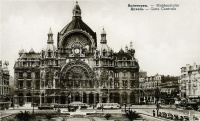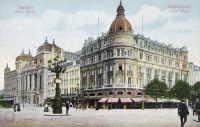19th-century architecture
From The Art and Popular Culture Encyclopedia
|
"The response of 19th-century architecture to industrialization, in stark contrast to the other arts, was to veer towards historicism. Although the railway stations built during this period are often considered the truest reflections of its spirit – they are sometimes called "the cathedrals of the age" – the main movements in architecture during the Industrial Age were revivals of styles from the distant past, such as the Gothic Revival."--Sholem Stein "Iron had been used constructionally in combination with glass as early as the middle of the century — as in the Crystal Palace in London [...] but engineering and architecture were still divorced, and in most buildings where these materials served in engineering construction their use was hidden by exterior coverings until in the Eiffel Tower (1889) it stood forth in complete freedom and pointed the way to new forms."--Gardner's Art Through the Ages (1926) by Helen Gardner |
|
Related e |
|
Featured: |
With the emerging knowledge in scientific fields and the rise of new materials and technology, architecture and engineering began to separate, and the architect began to concentrate on aesthetics and the humanist aspects, often at the expense of technical aspects of building design. There was also the rise of the "gentleman architect" who usually dealt with wealthy clients and concentrated predominantly on visual qualities derived usually from historical prototypes, typified by the many country houses of Great Britain that were created in the Neo Gothic or Scottish Baronial styles.
Formal architectural training in the 19th century, for example at École des Beaux-Arts in France, gave much emphasis to the production of beautiful drawings and little to context and feasibility. Effective architects generally received their training in the offices of other architects, graduating to the role from draughtsmen or clerks.
Meanwhile, the Industrial Revolution laid open the door for mass production and consumption. Aesthetics became a criterion for the middle class as ornamented products, once within the province of expensive craftsmanship, became cheaper under machine production.
Vernacular architecture became increasingly ornamental. House builders could use current architectural design in their work by combining features found in pattern books and architectural journals.
Revivalism and Eclecticism
The 19th century was dominated by a wide variety of stylistic revivals, variations, and interpretations. Revivalism in architecture is the use of visual styles that consciously echo the style of a previous architectural era. Modern-day Revival styles can be summarized within New Classical architecture, and sometimes under the umbrella term traditional architecture.
The idea that architecture might represent the glory of kingdoms can be traced to the dawn of civilisation, but the notion that architecture can bear the stamp of national character is a modern idea, that appeared in the 18th century historical thinking and given political currency in the wake of the French Revolution. As the map of Europe was repeatedly changing, architecture was used to grant the aura of a glorious past to even the most recent nations. In addition to the credo of universal Classicism, two new, and often contradictory, attitudes on historical styles existed in the early 19th century. Pluralism promoted the simultaneous use of the expanded range of style, while Revivalism held that a single historical model was appropriate for modern architecture. Associations between styles and building types appeared, for example: Egyptian for prisons, Gothic for churches, or Renaissance Revival for banks and exchanges. These choices were the result of other associations: the pharaohs with death and eternity, the Middle Ages with Christianity, or the Medici family with the rise of banking and modern commerce.
Whether their choice was Classical, medieval, or Renaissance, all revivalists shared the strategy of advocating a particular style based on national history, one of the great enterprises of historians in the early 19th century. Only one historic period was claimed to be the only one capable of providing models grounded in national traditions, institutions, or values. Issues of style became matters of state.
The most well-known Revivalist style is the Gothic Revival one, that appeared in the mid-18th century in the houses of a number of wealthy antiquarians in England, a notable example being the Strawberry Hill House. German Romantic writers and architects were the first to promote Gothic as a powerful expression of national character, and in turn use it as a symbol of national identity in territories still divided. Johann Gottfried Herder posed the question 'Why should we always imitate foreigners, as if we were Greeks or Romans?'.
In art and architecture history, the term Orientalism refers to the works of the Western artists who specialized in Oriental subjects, produced from their travels in Western Asia, during the 19th century. In that time, artists and scholars were described as Orientalists, especially in France.
In India, during the British Raj, a new style, Indo-Saracenic, (also known as Indo-Gothic, Mughal-Gothic, Neo-Mughal, or Hindoo style) was getting developed, which incorporated varying degrees of Indian elements into the Western European style. The Churches and convents of Goa are another example of the blending of traditional Indian styles with western European architectural styles. Most Indo-Saracenic public buildings were constructed between 1858 and 1947, with the peaking at 1880. The style has been described as "part of a 19th-century movement to project themselves as the natural successors of the Mughals". They were often built for modern functions such as transport stations, government offices, and law courts. It is much more evident in British power centres in the subcontinent like Mumbai, Chennai, and Kolkata.
Beaux-Arts
The Beaux-Arts style takes its name from the École des Beaux-Arts in Paris, where it developed and where many of the main exponents of the style studied. Due to the fact that international students studied here, there are buildings from the second half of the 19th century and the early 20th century of this type all over the world, designed by architects like Charles Girault and Thomas Hastings. Today, from Bucharest to Buenos Aires and from San Francisco to Brussels, the Beaux-Arts style survives in opera houses, civic structures, university campuses commemorative monuments, luxury hotels and townhouses. The style was heavily influenced by the Paris Opéra House (1860-1875), designed by Charles Garnier, the masterpiece of the 19th century renovation of Paris, dominating its entire neighbourhood and continuing to astonish visitors with its majestic staircase and reception halls. The Opéra was an aesthetic and societal turning point in French architecture. Here, Garnier showed what he called a style actuel, which was influenced by the spirit of the time, aka Zeitgeist, and reflected the designer's personal taste.
Beaux-Arts façades were usually imbricated, or layered with overlapping classical elements or sculpture. Often façades consisted of a high rusticated basement level, after it a few floors high level, usually decorated with pilasters or columns, and at the top an attic level and/or the roof. Beaux-Arts architects were often commissioned to design monumental civic buildings symbolic of the self-confidence of the town or city. The style aimed for a Baroque opulence through lavishly decorated monumental structures that evoked Louis XIV's Versailles. However, it wasn't just a revival of the Baroque, being more of a synthesis of Classicist styles, like Renaissance, Baroque, Rococo, Neoclassicism etc.
See also
- 19th century
- Architecture
- Industrial architecture
- Victorian architecture
- Revivalism (architecture)
- Eclecticism in architecture
- Victorian architecture
- Napoleon III style#Architecture
- Beaux-Arts architecture



